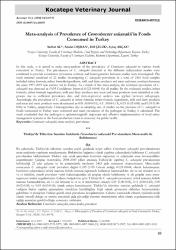Türkiye’de tüketime sunulan gıdalarda cronobacter sakazakii prevalansların meta-analiz ile belirlenmesi
Citation
Al, S. , Dışhan, A. , Çelik, E. & Akçay, A. (2020). Türkiye’de Tüketime Sunulan Gıdalarda Cronobacter sakazakii Prevalansların Meta-analiz ile Belirlenmesi . Kocatepe Veterinary Journal , 13 (1) , 69-76 . DOI: 10.30607/kvj.660115Abstract
Bu çalışmada, Türkiye’de tüketime sunulan çeşitli gıdalarda tespit edilen Cronobacter sakazakii prevalanslarının
meta-analizinin yapılması amaçlanmıştır. Birbirinden bağımsız olarak yapılmış çalışmalarda belirlenen C. sakazakii
prevalansları birleştirilerek Türkiye için ortak prevalans kestirimi sağlanmış ve çalışmalar arası heterojenlikler
araştırılmıştır. Çalışma materyalini, 2008-2019 yılları arasında Türkiye’de yapılmış C. sakazakii prevalansının
belirlendiği 22 adet çalışma ve bu çalışmalarda incelenen 2463 gıda numunesi oluşturmuştur. Meta-analiz
sonucunda C. sakazakii ortak prevalans değeri 0.033 (%95 Güven aralığı; 0.021-0.044) olarak bulunmuştur.
İncelenen çalışmalarda bebek maması, bebek maması yapımında kullanılan hammaddeler, süt ve süt ürünleri ve et
ve et ürünleri, yeterli prevalans verisi bulunduğundan alt gruplar olarak belirlenmiş ve alt gruplar arası metaregresyon analizi uygulanmıştır. Çalışma bulgularına göre Türkiye’de C. sakazakii prevalansı; bebek maması, bebek
maması hammaddeleri, süt ve süt ürünleri ve et ve et ürünlerinde sırasıyla 0.01 (0.00-0.01), 0.11 (0.04-0.18), 0.05
(0.02-0.08) ve 0.03 (0.00-0.06) olarak ortaya konulmuştur. Türkiye’de tüketime sunulan gıdalarda C. sakazakii
varlığına ilişkin yapılan çalışmaların örneklem büyüklüğüne bağlı olarak göstermiş oldukları heterojeniteler
giderilmiş ve patojenin Türkiye geneli ortak prevalansı hesaplanmıştır. Çalışma sonucunda etkenin epidemiyolojik
olarak önemli olduğu ve üretim zincirinde gıda güvenliği yönetim sistemlerinin etkin olarak uygulanmasının halk
sağlığı açısından gerekli olduğu sonucuna varılmıştır. In this study, it is aimed to make meta-analysis of the prevalence of Cronobacter sakazakii in various foods
consumed in Turkey. The prevalences of C. sakazakii detected in the different independent studies were
combined to provide a common prevalence estimate and heterogeneities between studies were investigated. The
study material consisted of 22 studies investigating C. sakazakii prevalence in a total of 2463 food samples
included infant formula, infant formula ingredients, milk and dairy products and meat and meat products between
the years 1997-2019 was carried out in Turkey. As a result of the meta-analysis, the common prevalence of C.
sakazakii was detected as (%95 Confidence Interval; 0.021-0.044) for all studies. In the evaluated studies, infant
formula, infant formula ingredients, milk and dairy products and meat and meat products were identified as subgroups due to sufficient prevalence data and meta-regression analysis was applied between sub-groups.
Accordingly, the prevalence of C. sakazakii in infant formula, infant formula ingredients, milk and dairy products
and meat and meat products were determined as 0.01 (0.00-0.01), 0.11 (0.04-0.18), 0.05 (0.02-0.08) and 0.03 (0.00-
0.06) in Turkey, respectively. Heterogeneities due to sampling size of studies on the presence of C. sakazakii in
foods consumed in Turkey were corrected and main prevalence of the pathogen in Turkey is calculated. The
study concluded that the pathogen is epidemiologically important and effective implementation of food safety
management systems in the food production chain is necessary for public health.
Source
Kocatepe Veteriner DergisiVolume
13Issue
1URI
https://dergipark.org.tr/tr/pub/kvj/issue/50428/660115https://doi.org/10.30607/kvj.660115
https://hdl.handle.net/11630/9238
Collections
- Cilt 13 : Sayı 1 [13]



















